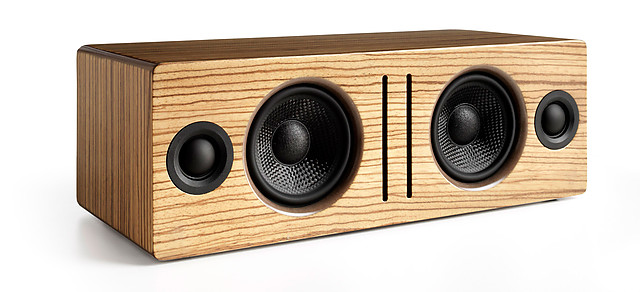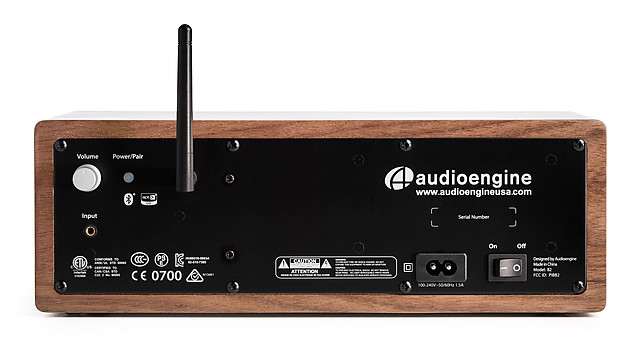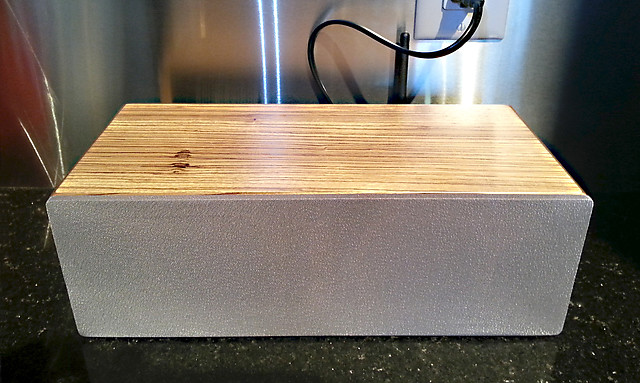Audioengine B2… Fun in a Box
My name is Oliver, and I’m a geek. It’s an affliction I enjoy at both work and play. My world is filled with stuff that makes music, from real humans playing real wooden instruments, to various boxes of base metal, wood and more exotic materials, like silicon and niobium. I carry a little yellow triangle, filled with magic and many songs, that makes beautiful music for me wherever I go. Sometimes though, I simply want to make a pizza or read a book unencumbered by headphones yet still have the comfort and joy of beautiful sounds around me. For that, I need a different sort of creature…
A long time ago, there were “radios.” Not console models, but simple radios; small appliances that received music, news and drama from the ether. That product category is largely gone now, replaced by small boxes that receive their signals in other ways, but still serve that purpose of casual music at hand.
Battery-powered portables abound, from the more esoteric Grain Audio’s portable PWS to mass market models with their crispy, overcooked mids and no real high end or bottom to speak of. From Sony, you have the dark and midrangey SRS-X3, or, for over twice the price, there’s the Bose Soundlink Mobile II with its lackluster presentation and sucked out upper mids. There is also a plethora of iPod docks, portable or otherwise, most of which share an embarrassing kinship with their portable brethren: an utter lack of fidelity. From those design-crazy Danes, the BeoPlay A2 bucks the trend, doing a great job of rockin’ the mids and highs. Almost all of these offerings, despite their designer’s usually disappointing best efforts, lack one key aspect: real bass. Without exceptional engineering, they can’t produce any satisfying low end. There are exceptions… Bowers & Wilkins’ Zeppelin Air is an outstanding stay-at-home docking solution, and Definitive Technology’s Cube captures enough volume to perform well at low frequencies.
I already own what I think is the best portable speaker system, the pocketable foxL from Soundmatters, a tiny but mighty example of what happens when innovative thinking meets careful engineering, and which I still consider a reference design for a portable speaker. I reviewed the foxL for blogcritics.org back in 2011. Soundmatters have recently upped the ante with a palm-sized, battery-powered subwoofer, the foxLO, designed to connect to a foxL or any small speaker that needs some low-frequency help. But most folks who care about sound quality already have a pair of headphones or earphones to use with their smart phone or file-playing iPod equivalent. What they often lack is a compact, mains-powered stereo speaker that serves multiple masters. This is the modern equivalent of a hi-fi clock radio, without the clock…
While I was attending recent audio shows, including the 2014 CAS and this year’s RMAF (audioXpress, January 2015), I dropped by the folks at Audioengine. They excel at creating high excitement in a small form factor. As reported in my last HifiZine installment, I was quite impressed with the “…new B1 wireless Bluetooth receiver ($190) from Audioengine. For a Bluetooth link, it sounded great, and when mated to their A5+ two way ($400), made for an awesome second system for office, kitchen or boudoir.” Now, imagine that B1 built into a cabinet containing two of their powered A2+ two-ways, oriented slot-to-slot in a landscape configuration. The result? The new B2, a mains-powered, self-enclosed stereo speaker system that looks great while rocking the house. Actually, in my case it’s the kitchen, the bedroom and the bath; all the places the “big” system I use for reviews can’t adequately reach.

The B2’s ports are front facing for easy placement, and the magnetically attached grill pops on or off
As with other Audioengine products, the engineered-wood cabinetry is hand-built in Asia, with radiused edges and a substantial feel. The overall dimensions are 4.25” tall, 12.25” wide, and 5.5” deep. The jointed stub antenna protrudes a minimum of 1.5” from the back.

The rear is uncluttered for easy setup, and the antenna can be oriented as desired
The B2 combines a Bluetooth receiver with TI’s PCM5102A 24-bit DACs. The converters feed 15 WRMS (AES) class AB monolithic amplifiers, with a ganged volume control, easily reached on the back of the cabinet. An analog input on 1/8th inch TRS is also available on the back, and a 1.5 meter male-to-male cable is included, as well as a microfiber bag to wrap the B2 for transport to the dorm or guest room. When you look at the B2 from a computer’s perspective, as I did with my laptop running Mac OS X 10.9, the system appears as a 2-channel 44.1 kHz, “32 bit float” device. That aligned with Core Audio’s native operation as single precision floating point. The same would be true for Windows.
The DAC pads all bit depths internally to 24, achieving a higher signal-to-noise ratio. This is basically the same design used in their D3 USB DAC and B1 Bluetooth receiver products. Brady Bargenquast, co-founder and co-designer at Audioengine, let me know that, “most audiophiles are OK with this, while others not so much. We really like the way it sounds, however, so that was our driving decision although we do have other non-upsampling ‘native’ DACs as well – the D1, D2, and W3.”
The heavily regulated, universal switch mode power supply is built in, with the mains switch on the back. The electronics drop into quiescent mode when not in use to save energy. At idle, the current draw was 4.8 to 5.1 Watts. When cranked, I never saw more than 12W, regardless of usage pattern, and that 12 Watts produced a ridiculously loud result.
Back to Bluetooth. The B2 is easy to set up and pair, and supports two profiles: A2DP (Advanced Audio Distribution Profile) and AVRCP (Audio/Video Remote Control Profile). For the over two dozen transmitter brands that incorporate aptX – including Burmester, Cambridge Audio, Chord, Krell, Musical Fidelity, NAD, Pioneer, Quad, Roksan, Sony, and Teac – the B2 also receives aptX-encoded audio over Bluetooth. This pre-encoding, via the aptX lossy codec, enables better quality over Bluetooth’s limited data rate “pipe.” Even my Samsung Galaxy S III includes aptX. Due to careful engineering, the B2 has much better range than your average Bluetooth widget. I was able to reliably connect through three walls over a 36 foot distance, from office to bedroom. A line-of-sight connection would probably extend to 50 feet or more since the spec says twice that!

My review B2 arrived in Zebrawood livery with a medium gray grill, making a handsome accent to my black stone countertops. Walnut and black ash finishes are also available.
Audioengine’s marketing lit says that the B2’s voicing is based, “…on the signature sound of our award-winning A2+ powered desktop speakers.” Frankly, that’s the reason I requested a review loaner. The A2+ is a fantastic performer for its price, and I thought it would be interesting to hear a mini-console version. I asked Bargenquast about some engineering specifics on the B2…“We design and manufacture our own tweeters, woofers, and most other components. What we don’t fabricate directly in our factories, we have custom-made to our specifications, parts such as toroidal transformers, magnets, and wiring harnesses, for example.” In this case, those drivers are ferrofluid-cooled, silk dome tweeters with neodymium magnets, and Kevlar aramid/woven glass composite cone woofers with rubber surrounds. The power amps are analog, class A/B, and the crossovers “…are a passive analog design.” The rated response is a very respectable 65 to 22 kHz, ±2 dB. Concerning the wood-veneered MDF cabinet, Bargenquast gave me the X-ray view: “The B2 cabinet is a unique design in that it has dual sub-enclosures to prevent cross-interference while each side contains its own tuned, front-port bass slot. So the cabinet is actually two separate A2+ speaker cabinets put together with a high density foam gasket between and industrial adhesive holding them together… then the wood veneer is applied over this construction.” The port slots are tuned to around 65 Hz.
Out of the box, the B2 was in fine form; no break-in was needed. Smooth and honest, with nice high frequency extension and no resonances poking out. There’s plenty of detail without the tizzy treble found in lesser products. The rolled-off high end of FM radio was readily apparent, as was the high frequency improvements gained from high rez files versus CD. The freefield low frequencies had a pleasant richness, while placing it on a counter or against a back wall lent a chesty fatness to the bottom in keeping with boundary conditions – just right for the Beats Generation. For its price and size, Audioengine’s B2 is a stellar performer. With a thirty-day trial listen from the Audioengine store, it’s a tough one to beat…
Hope you had a happy holiday season, everyone, and thanks for listening!
Manufacturer information
Audioengine, http://audioengineusa.com/
+1-877-853-4447 or through a local dealer
B2 Bluetooth Speaker, MSRP USD299
Music in heavy rotation during this review
- Chrissie Hynde — Stockholm (2014 Caroline; Compact Disc) Ms. Hynde continues to deliver cutting commentary dripping with weltschmerz via her signature rakish rock style
- Killers — Hot Fuss (2004 Island; Compact Disc) Chock full of hooky rock and danceable pop fun
- Aimee Mann — Charmer (2012 SuperEgo; Compact Disc) Hook-filled pop perfection
- Andrés Segovia — 20th Century Masters – The Millennium Collection: Best of Andrés Segovia (2004 Deutsche Grammophon; Compact Disc) He’s pickin’ and I’m grinnin’!
- Ken Thomson and Slow/Fast — Settle (2014 NCM East; Compact Disc) Echos of Zappa’s best orchestration within a complex, melodic jazz framework
- Robin Ticciati and the Scottish Chamber Orchestra — Schumann: The Symphonies (2014 Linn; 192k ALAC) Beautifully performed, contemplative music for a dull day
Additional gear used for this review
- Sources: Amarra Symphony w/iRC, iTunes, Onkyo TX-8211, Samsung Galaxy S III
- Conversion & pre-amplification: Astell&Kern AK120, PonoMusic PonoPlayer




than the Audioengine B2, and it sounds that way. Just be aware of its seemingly emphasized bass, which ought to make it really shine in a portable home theater type of environment, but maybe not as much for someone just looking to listen to music.
Hey Slava,
Considering the box size, true bottom octave “bass” is being a bit optimistic. It does have a typical port resonance, so I’d say “warmth” is more like it. That said, the B2 is more neutral sounding than the majority of small powered speakers out there today. If that warmth isn’t to your particular taste, then a touch of EQ would correct it.
what type of wood is this?